 | |
| Founded | 6 June 1844 |
|---|---|
| Founder | George Williams |
| Founded at | London, England |
| Type | International NGO |
| Headquarters | Geneva, Switzerland |
Region served | Worldwide |
President | Soheila Hayek |
Secretary General | Carlos Sanvee |
Staff | 88,485 (2018) |
Volunteers | 919,671 (2018) |
| Website | ymca |
Formerly called | Young Men's Christian Association |

YMCA, sometimes regionally called the Y, is a worldwide youth organization based in Geneva, Switzerland, with more than 64 million beneficiaries in 120 countries.[1] It was founded on 6 June 1844 by George Williams in London, originally as the Young Men's Christian Association, and aims to put Christian values into practice by developing a healthy "body, mind, and spirit".
From its inception, it grew rapidly and ultimately became a worldwide movement founded on the principles of muscular Christianity. Local YMCAs deliver projects and services focused on youth development through a wide variety of youth activities, including providing athletic facilities, holding classes for a wide variety of skills, promoting Christianity, and humanitarian work.
YMCA is a non-governmental federation, with each independent local YMCA affiliated with its national organization. The national organizations, in turn, are part of both an Area Alliance (Europe, Asia Pacific, the Middle East, Africa, Latin America and the Caribbean, the United States, and Canada) and the World Alliance of YMCAs (World YMCA). Consequently, all YMCAs are unique, while following certain shared aims, such as the Paris Basis.
The YMCA was also considered a parachurch organization based on Protestant values.[2][3] Similar organizations include the Young Women's Christian Association (YWCA) and the Young Men's Hebrew Association (YMHA).
In popular culture, the YMCA is the subject of the 1978 song "Y.M.C.A." by the Village People.
History
Origins
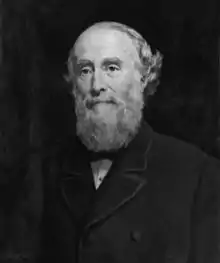
The Young Men's Christian Association (YMCA) was founded by George Williams and 11 friends.[4] Williams was a London draper who was typical of the young men drawn to the cities by the Industrial Revolution. They were concerned about the lack of healthy activities for young men in major cities; the options available were usually taverns and brothels. Williams' idea grew out of meetings he held for prayer and Bible-reading among his fellow workers in a business in the city of London,[5] and on 6 June 1844, he held the first meeting that led to the founding of YMCA with the purpose of "the improving of the spiritual condition of young men engaged in the drapery, embroidery, and other trades."[6] Anthony Ashley-Cooper, 7th Earl of Shaftesbury served as YMCA's first president from 1851 until his death in 1885.[7]
By 1845, YMCA started a popular series of lectures that from 1848 were held at Exeter Hall, London, and started being published the following year, with the series running until 1865.[8]
YMCA was associated with industrialisation and the movement of young people to cities to work. YMCA "combined preaching in the streets and the distribution of religious tracts with a social ministry. Philanthropists saw them as places for wholesome recreation that would preserve youth from the temptations of alcohol, gambling, and prostitution and that would promote good citizenship."[9]
Movement

The YMCA spread outside the United Kingdom in part thanks to the Great Exhibition of 1851, the first in a series of World's Fairs which was held in Hyde Park, London.[7] Later that year there were YMCAs in Australia, Belgium, Canada, France, Germany, the Netherlands, Switzerland, Hong Kong, and the United States.
The idea of creating a truly global movement with an international headquarters was led by Henry Dunant, Secretary of YMCA Geneva, who would later go on to found the International Committee of the Red Cross and win the first Nobel Peace Prize. Dunant successfully convinced YMCA Paris to organise the first YMCA World Conference. The Conference took place in August 1855, bringing together 99 young delegates from nine countries, held before the Exposition Universelle (1855). They discussed joining in a federation to enhance cooperation amongst individual YMCA societies. This marked the beginning of the World Alliance of YMCAs. The conference adopted the Paris Basis, a common mission for all present and future national YMCAs.[10] Its motto was taken from the Bible, "That they all may be one" (John 17:21).
Other ecumenical bodies, such as the World YWCA, the World Council of Churches, and the World Student Christian Federation have reflected elements of the Paris Basis in their founding mission statements. In 1865, the fourth World Conference of YMCAs, held in Germany, affirmed the importance of developing the whole individual in spirit, mind, and body. The concept of physical work through sports, a new concept for the time, was also recognized as part of this "muscular Christianity".
YMCA has cooperated with camping organizations such as Camp Fire (organization), Girl Scouts of the USA, and Boy Scouts of America. This lasted from 1989 to 2015.
Two themes resonated during the first World Conference: the need to respect the local autonomy of YMCA societies, and the purpose of YMCA: to unite all young, male Christians for the extension and expansion of the Kingdom of God. The former idea is expressed in the preamble:
The delegates of various Young Men's Christian Associations of Europe and America, assembled in Conference at Paris, the 22 August 1855 feeling that they are one in principle and in operation, recommend to their respective Societies to recognize with them the unity existing among their Associations, and while preserving a complete independence as to their particular organization and modes of action, to form a Confederation of secession on the following fundamental principle, such principle to be regarded as the basis of admission of other Societies in future.
1870s to 1910s

YMCA was very influential during the 1870s and the 1930s, during which times it most successfully promoted "evangelical Christianity in weekday and Sunday services, while promoting good sportsmanship in athletic contests in gyms (where basketball and volleyball were invented) and swimming pools."[9] Later in this period, and continuing on through the 20th century, YMCA had "become interdenominational and more concerned with promoting morality and good citizenship than a distinctive interpretation of Christianity."[9] Starting before the American Civil War,[11] YMCA provided nursing, shelter, and other support in wartime in the US.

In 1878, the World YMCA offices were established in Geneva, Switzerland by Dunant. Later, in 1900, North American YMCAs, in collaboration with the World YMCA, set up centres to work with emigrants in European ports, as millions of people were leaving for the US. In 1880, in Norway, YMCA became the first national organization to adopt a strict policy of equal gender representation in committees and national boards.

.jpg.webp)
In 1885, Camp Baldhead (later known as Camp Dudley), the first residential camp in the United States and North America, was established by George A. Sanford and Sumner F. Dudley, both of whom worked for YMCA. The camp, originally located near Orange Lake in New Jersey, moved to Lake Wawayanda in Sussex County the following year, and then to the shore of Lake Champlain near Westport, New York, in 1891.[13][14]
The YMCA was an early influence on scouting that began in the UK in 1907. The year after its inception by Robert Baden-Powell, the first scout troops met in the Nottingham and Birkenhead YMCA buildings.[15] The YMCA would also influence the Boy Scouts of America (BSA) and German Scouting. Edgar M. Robinson, a Chicago-area YMCA administrator, worked at YMCA while also becoming the BSA's first director.
In 1916, K. T. Paul became the first Indian national general secretary of India. Paul had started rural development programs for self-reliance of marginal farmers, through co-operatives and credit societies. These programmes became very popular. He also coined the term "rural reconstruction", and many of the principles he developed were later incorporated into the Indian's government nationwide community development programs. In 1923, Y. C. James Yen, of YMCA China, devised the "thousand character system", based on pilot projects in education. The method also became very popular, and in 1923, it led to the founding of the Chinese National Association of the Mass Education Movement. In 1878, YMCA was organized near the Jaffa Gate of the Old City of Jerusalem and the current landmark building was dedicated by General Lord Allenby in 1933 during the British Mandate of Palestine.
By then, most of the YMCA had central offices in Gainesville, Florida; Tokyo, Japan; Denver, Colorado; and Madrid, Spain.
The World Wars
Within ten days of the declaration of World War I, YMCA had established no fewer than 250 recreation centres, also known as huts, in the United Kingdom, and would go on to build temporary huts across Europe to support both soldiers and civilians alike, run by thousands of volunteers. Notable supporters and volunteers included Clementine Churchill[16] (for which she was appointed a Commander of the Order of the British Empire (CBE) in 1918), Oswald Chambers and Robert and Olave Baden-Powell.[17] Within the first month the YMCA Women's Auxiliary was formed, and Princess Helena Victoria of Schleswig-Holstein would go on to become a notable member and chairman of its organising committee.[18]
During World War I, YMCA raised and spent over $155 million on welfare efforts for American soldiers. It deployed over 25,000 staff in military units and bases from Siberia to Egypt to France. They took over the military's morale and comfort operations worldwide. Irving Berlin wrote Yip Yip Yaphank, a revue that included a song entitled "I Can Always Find a Little Sunshine in the YMCA". Frances Gulick was a YMCA worker stationed in France during World War I who received a United States Army citation for valour and courage on the field.[19]
During World War II, YMCA was involved in supporting millions of POWs and in supporting Japanese Americans in internment camps. This help included helping young men leave the camps to attend Springfield College and providing youth activities in the camps. In addition, YMCA was one of seven organizations that helped to found the USO.
In Europe, YMCA helped refugees, particularly displaced Jews. Sometimes YMCA participated in escape operations.[20] Mostly, however, its role was limited to providing relief packages to refugees.[21]
It was also involved in war work with displaced persons and refugees. It set up War Prisoners Aid to support prisoners of war by providing sports equipment, musical instruments, art materials, radios, gramophones, eating utensils, and other items. Donald Lowrie of the YMCA took the helm of the Committee of Nîmes (also known as the Camps Committee), a group that gathered leaders from over twenty humanitarian organizations coordinate advocacy for people in the internment camps, including helping children leave these camps to live in children's colonies or eventually escape to freedom.[22]
From the 1940s
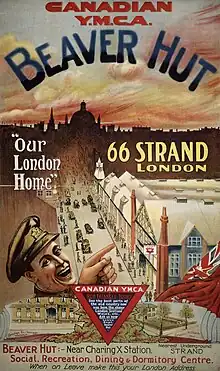
YMCA Motion Picture Bureau, renamed Association Films in 1946, was one of the UK's largest non-theatrical distribution companies.[23] In 1947 the World YMCA gained special consultative status with the United Nations Economic and Social Council. In 1955 the first black President of the World YMCA, Charles Dunbar Sherman from Liberia, was elected. At 37 years, he was also the youngest president in World YMCA history. In 1959 YMCA of the USA developed the first nationally organized scuba diving course and certified their first skin and scuba diving instructors.[24][25] By 1974, YMCA had set up a curriculum to begin teaching cave diving.[26]

In 1973, the Sixth World Council in Kampala, Uganda, became the first World Council in Africa, hosted by Uganda YMCA. It reaffirmed the Paris Basis and adopted a declaration of principles, known as the Kampala Principles.[27] It include the principles of justice, creativity and honesty. It stated what had become obvious: that a global viewpoint was more necessary. It also recognized that YMCA and its national member organizations would have to take political stands, particularly in international challenges and crises.
In 1976, YMCA of the USA appointed Violet King Henry to executive director to its Organizational Development Group, making her the first woman named to a senior management position with the American national YMCA.
In 1985, the World Council of YMCAs passed a resolution against apartheid, and anti-apartheid campaigns were formed under the leadership of Lee Soo-Min (Korea), the first Asian secretary general of the World YMCA.
Challenge 21 and recent years
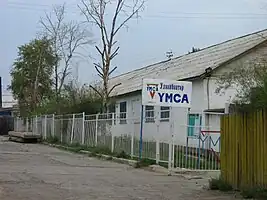
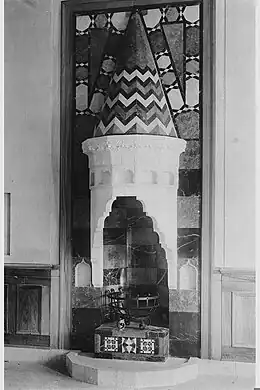
In 1998, the 14th World Council of YMCAs in Germany adopted "Challenge 21",[28] intended to place more focus on global challenges, such as gender equality, sustainable development, war and peace, fair distribution, and the challenges of globalization, racism, and HIV/AIDS.
Affirming the Paris Basis adopted in 1855, as the ongoing foundation statement of the mission of YMCA, at the threshold of the third millennium, we declare that YMCA is a worldwide Christian, ecumenical, voluntary movement for women and men with special emphasis on and the genuine involvement of young people and that it seeks to share the Christian ideal of building a human community of justice with love, peace and reconciliation for the fullness of life for all creation.
Each member YMCA is therefore called to focus on certain challenges which will be prioritized according to its own context.
These principles are an evolution of the Kampala Principles
- Sharing the good news of Jesus Christ and striving for spiritual, intellectual and physical well-being of individuals and wholeness of communities.
- Empowering all to take increased responsibilities and assume leadership at all levels and working towards an equitable society.
- Advocating for and promoting the rights of and upholding the rights of children.
- Fostering dialogue and partnership between people of different faiths and ideologies and recognizing the cultural identities of people and promoting cultural renewal.
- Committing to work in solidarity with the poor, dispossessed, uprooted people and oppressed racial, religious and ethnic minorities.
- Seeking to be mediators and reconciles in situations of conflict and working for meaningful participation and advancement of people for their own self-determination.
- Defending God's creation against all that would destroy it and preserving and protecting the earth's resources for coming generations. To face these challenges, YMCA will develop patterns of co-operation at all levels that enable self-sustenance and self-determination.
— Challenge 21, World Alliance of YMCAs
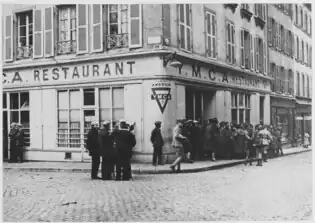
In 2002, the World Council in Oaxtepec, Morelos, in Mexico, called for a peaceful solution to the Middle East crisis. On 12 July 2010, YMCA of the USA rebranded its name to the popular nickname "The Y" and revised the iconic red and black logo to create five colored versions.[29][30] Today, YMCAs are open to all, regardless of ability, age, culture, ethnicity, gender, race, religion, sexual orientation and socioeconomic background.[31]

During the 19th World Council meeting in 2018 in Chiang Mai, Carlos Sanvee from Togo became the first African and current Secretary General of World YMCA. During the same World Council meeting, Patricia Pelton from Canada emerged as the first female President of World YMCA.
YMCA's 175th anniversary in 2019 was celebrated with a global gathering of the organisation's young leaders at ExCeL London from 4 to 7 August, with 3,200 people from 100 countries. The event celebrated youth leadership, and elevated the United Nations Sustainable Development Goals.[32] It was attended by guests including the Jayathma Wickramanayake on behalf of Office of the Secretary-General's Envoy on Youth and María Fernanda Espinosa, the President of the United Nations General Assembly.[33]
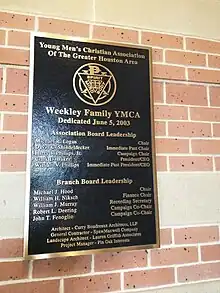
Global structure
A federated model of governance has created a diversity of YMCA programmes and services, with YMCAs in different countries and communities offering vastly different programming in response to local community needs.[34] Financial support for local associations is derived from programme fees, membership dues, community chests, foundation grants, charitable contributions, sustaining memberships, corporate sponsors and other funding models used in the charitable sector.

.jpg.webp)
YMCA globally operates on a federation model, with each independent local YMCA affiliated with its national organization, known as a National Council. The national organizations, in turn, are affiliated to both an Area Alliance (Europe, Asia Pacific, the Middle East, Africa, Latin America and the Caribbean, Mexico, the United States, and Canada) and the World YMCA. The World YMCA is the highest affiliation body. Each local, national and regional YMCA is independent of each other, but local, regional and international cooperation, partnerships and collaborations are part of the organizations work. Each National Council is led by a National General Secretary, a role that is akin to that of a CEO. At each stage of the affiliation process, there are usually membership fees i.e. local YMCA to National Movement.
Ever since the first World Conference in August 1855, in Paris, the World YMCA has convened a World Conference (later renamed World Council) every three to four years and is YMCA's highest decision making forum. Every National Council sends a delegation who hold a number of votes, which are dependent on the financial turnover of that National Council. The World Council is "responsible for setting the policies and direction of the World YMCA, electing its Officers and Executive Committee, evaluating the work of the last four years, and deliberating on priorities for the next quadrennium". The most recent World Council took place in 2022 in Aarhus, Denmark,.[35] and the 21st World Council is scheduled for July 2026 in Toronto, Ontario, Canada.
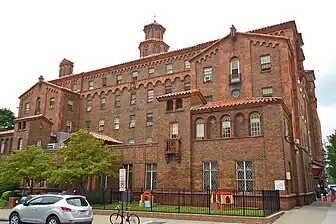
YMCA Vision 2030
At the 20th World Council in Aarhus, Denmark, the global YMCA Movement adopted the first-ever collective strategy, YMCA Vision 2030.
Vision 2030 serves as a roadmap for every YMCA’s strategic goals. Closely aligned to the UN Sustainable Development Goals, Vision 2030 empowers communities and young people worldwide to build a just, sustainable, equitable and inclusive world.
Collective Vision: A world where every person lives in harmony with self, with society and with creation.
Collective Mission: The YMCA's mission is to empower young people and communities worldwide to build a just, sustainable, equitable and inclusive world, where every person can thrive in body, mind and spirit.
Pillars of Impact: To achieve the mission, the YMCA fill focus on 4 thematic areas and work towards 12 Strategic Goals. The Pillars are Community Wellbeing, Meaningful Work, Sustainable Planet and Just World. Each Pillar has three goals: Internal Transformation, Community Empowerment and Global Advocacy.
As of June 2023, 75 YMCA Movements worldwide were in the process of implementing YMCA Vision 2030.
| Number | Date | Name | Location | Country |
|---|---|---|---|---|
| 1 | 1855 | First World Conference | Paris | |
| 2 | 1858 | Second World Conference | Geneva | |
| 3 | 1862 | Third World Conference | London | |
| 4 | 1865 | Fourth World Conference | Elberfeld | |
| 5 | 1867 | Fifth World Conference | Paris | |
| 6 | 1872 | Sixth World Conference | Amsterdam | |
| 7 | 1875 | Seventh World Conference | Hamburg | |
| 8 | 1878 | Eighth World Conference | Geneva | |
| 9 | 1881 | Ninth World Conference | London | |
| 10 | 1884 | 10th World Conference | Berlin | |
| 11 | 1888 | 11th World Conference | Stockholm | |
| 12 | 1891 | 12th World Conference | Amsterdam | |
| 13 | 1894 | 13th World Conference | London | |
| 14 | 1898 | 14th World Conference | Basel | |
| 15 | 1902 | 15th World Conference | Christiania | |
| 16 | 1905 | 16th World Conference | Paris | |
| 17 | 1909 | 17th World Conference | Elberfeld | |
| 18 | 1913 | 18th World Conference | Edinburgh | |
| 19 | 1926 | 19th World Conference | Helsinki | |
| 20 | 1931 | 20th World Conference | Cleveland | |
| 21 | 1937 | 21st World Conference | Mysore | |
| 22 | 1955 | First World Council | Paris | |
| 23 | 1957 | Second World Council | Kassel | |
| 24 | 1961 | Third World Council | Geneva | |
| 25 | 1965 | Fourth World Council | Gotemba, Shizuoka | |
| 26 | 1969 | Fifth World Council | Nottingham | |
| 27 | 1973 | Sixth World Council | Kampala | |
| 28 | 1977 | Seventh World Council | Buenos Aires | |
| 29 | 1981 | Eighth World Council | Estes Park, Colorado | |
| 30, 31 | 1985 | Ninth and 10th World Council | Nyborg | |
| 32 | 1988 | 11th World Council | Aruba | |
| 33 | 1991 | 12th World Council | Seoul | |
| 34 | 1994 | 13th World Council | Coventry | |
| 35 | 1998 | 14th World Council | Frechen | |
| 36 | 2002 | 15th World Council | Mexico City | |
| 37 | 2006 | 16th World Council | Durban | |
| 38 | 2010 | 17th World Council | Hong Kong | |
| 39 | 2014 | 18th World Council | Estes Park, Colorado | |
| 40 | 2018 | 19th World Council | Chiang Mai | |
| 41 | 2022 | 20th World Council | Aarhus | |
Logo

In 1881, 26 years after its foundation, the official emblem of the World Alliance of YMCAs was adopted, at the Ninth International YMCA World Conference, in London. The circular emblem is made up of five segments, one for each continent. The segments are held together by small monograms of YMCA in different languages. As early as 1881, YMCA leaders believed the Movement could be truly international and united across borders. In the center is a larger monogram of X and P, Chi and Rho, Christ's name, as used by early Christians. An open Bible sits on top of the monogram, showing John XVII, Verse 21, "that they all may be one". This was to remind YMCAs that Christ is at the center of the Movement, a source of strength, hope and unity, binding them all together.[37]
In 1891, Luther Gulick (physician), a physical education director at YMCA of the US, introduced a new emblem to represent YMCA, an inverted red triangle. Each of the triangle's sides represented 'the whole man' and a different aspect of YMCA's work as recognised by Gulick; Mind, Body and Spirit.[38] So significant was the red triangle, it would go on to become a familiar symbol of YMCA's work on the home front and around the world during WW1 and WW2. The red triangle is still used as part of many local, national and regional YMCA logos today.
In 2010, the YMCA of the USA changed its logo to "The Y" as part of a larger brand transformation.[39]
Activities
Accommodation
YMCAs around the world offer various types of accommodation. In some places this takes the form of budget accommodation available to the public such as youth hostels, or hotels which in turn generate income for other charitable activities. In England and Wales, YMCAs offer supported accommodation for vulnerable and homeless young people.[40]
Education and academia
Multiple colleges and universities have historically had connections to YMCA. Springfield College, of Springfield, Massachusetts, was founded in 1885 as an international training school for YMCA Professionals, while one of the two schools that eventually became Concordia University—Sir George Williams College—started from night courses offered at the Montreal YMCA. Northeastern University began out of a YMCA in Boston, and Franklin University began as YMCA School of Commerce. San Francisco's Golden Gate University traces its roots to the founding of YMCA Night School on 1 November 1881. Detroit College of Law, now the Michigan State University College of Law, was founded with a strong connection to the Detroit, Michigan YMCA. It had a 99-year lease on the site, and it was only when it expired that the college moved to East Lansing, Michigan. Youngstown State University traces its roots to the establishment of a law school by the local YMCA in 1908. The Nashville School of Law was YMCA Night Law School until November 1986, having offered law classes since 1911 and the degree of Juris Doctor since January 1927. YMCA pioneered the concept of night school, providing educational opportunities for people with full-time employment. Many YMCAs offer ESL programs, alternative high school, day care, and summer camp programs. In India, YMCA University of Science and Technology of Faridabad was founded in 1969. It offers various programs related to science and engineering. During the 1880s, the Cleveland YMCA began to offer day and evening courses to students who did not otherwise have access to higher education. The YMCA program was reorganized in 1906 as the Association Institute, and this in turn was established as Fenn College in 1929. In 1964, Fenn College became a state college named Cleveland State University.
American high school students have a chance to participate in YMCA Youth and Government, wherein clubs of children representing each YMCA community convene annually in their respective state legislatures to "take over the State Capitol for a day."
American students in Title One public schools are sometimes eligible to join a tutoring program through YMCA called Y Learning. This program is used to help low-income students who are struggling in school complete their homework with help from tutors and receive a snack as well as a safe place to be after school. Y Learning operates under the main mission of bridging achievements gaps and providing essential resources to help underprivileged students thrive in school.[41]
The International Coalition of YMCA Universities[42] brings together universities from all over the world, including Brazil, England, Germany, Hong Kong, India, Mexico, Uruguay, United States, and Venezuela. The universities offer a wide variety of courses on different levels.
Health and wellbeing

In 1891, James Naismith, a Canadian American, invented basketball while studying at YMCA International Training School in Springfield, Massachusetts (later to be named Springfield College). Naismith had been asked to invent a new game in an attempt to interest pupils in physical exercise. The game had to be interesting, easy to learn, and easy to play indoors in winter. In 1895, William G. Morgan from YMCA of Holyoke, Massachusetts, invented the sport of volleyball as a slower-paced alternative sport, in which the older YMCA members could participate. In 1930, Juan Carlos Ceriani from YMCA of Montevideo, Uruguay, invented the sport of futsal, an indoor version of football, having been created in synthesis with the rules of the three indoor sports of handball, basketball and water polo.
Public health
The organization is committed to public health in different ways. It organizes fitness and wellness as well as help and awareness programs. One of the programs is the Diabetes Prevention Program, where trained staff members help sick persons to make their lives healthy and active.[43]
Basketball
Basketball was invented at YMCA, in Springfield, Massachusetts, in 1891 by Dr. James Naismith, a clergyman, educator and physician.[44] Naismith was asked to create an indoor "athletic distraction" to keep rowdy youth busy in the cold New England winter months. Luther Gulick (physician), the head of Springfield YMCA gave Naismith two weeks to come up with a game to occupy a particularly incorrigible group. Naismith decided the game had to be physically active, simple to understand and would have minimal physical roughness.
The first contest was played at the International YMCA Training School in December 1891.[45] During those earliest games the school's custodian, "whose antipathy to the students was well known," retrieved successful shots from the baskets – using a ladder.[46] The original game was played with a soccer ball and two peach baskets nailed to the balcony of Springfield YMCA. The game was an immediate hit, although originally the baskets still had their bottoms, and the ball had to be manually retrieved after each score, considerably slowing play. It was mostly a passing game, and dribbling did not become a major part of the game until much later, when the ball was improved to its present form.
Gulick worked with Naismith to spread the sport, chairing the Basketball Committee of the Amateur Athletic Union (1895–1905) and representing the United States Olympic Committee during the 1908 Olympic Games. Naismith and his wife attended the 1936 Summer Olympics when basketball was included for the first time as an Olympic event.[47] For his efforts to increase the popularity of basketball and of physical fitness in general, Gulick was inducted into the Basketball Hall of Fame as a contributor in 1959.
Volleyball
Four years after James Naismith invented basketball in Springfield in 1891, William G. Morgan, an instructor at YMCA in Holyoke, Massachusetts, wanted to create a game for older gentlemen which had less physical contact. He borrowed a tennis net, raised it 6 feet, 6 inches above the floor, and invented the game of "mintonette", which could be played by a group of any number and involved volleying a large ball over the net. An observer suggested that a better name for the new sport would be "volleyball". In 1912, J. Howard Crocker introduced volleyball to schools and YMCA locations in China.[lower-alpha 1]
Racquetball
Racquetball is another YMCA invented sport. Joseph Sobek a tennis, handball and squash player who worked in a rubber manufacturing factory, was dissatisfied with the options for indoor sports in Greenwich, Connecticut. He could not find squash players of his caliber and he did not care particularly for handball, so in 1950 he designed a short, stringed racquet, used a children's toy rubber ball, and created rules for a new game using the handball courts. He called his new sport "paddle rackets". The sport really took off in the 1970s and there are an estimated 15 million players worldwide today.[50]
_-_DPLA_-_d519c56d87005699c867d5febfb6a03b.jpg.webp) War Relief YMCA
War Relief YMCA YMCA library in Charleston SC
YMCA library in Charleston SC YMCA Huntington, West Virginia 2022
YMCA Huntington, West Virginia 2022
Gymnastics
Gymnastics came to be at the YMCA in 1869. Three YMCAs; Boston, San Francisco, and New York (23rd St Branch) all built buildings with gyms inside. These gyms then allowed men to train on the sport of gymnastics. Although, most of the men who knew gymnastics were circus performers and did not fit the ideas and values of the YMCA. Robert J. Roberts was one of the original circus performers at the Boston YMCA in the 1870s and 1880s but he got hurt due to a fall and could not perform or teach gymnastics. This led him to start the group exercises we see at the YMCA today.[51] Even though Robert stopped teaching gymnastics in Boston another YMCA was creating the sport of gymnastics, the Salem YMCA was holding boy/men classes as far back as 1895 where they could learn parallel and horizontal bars, "German horse," mat exercises, juggling, and weight lifting. They would then train to perform for an audience. A few years later, gymnastics began to filter out of the YMCA due to group sports such as volleyball and basketball becoming more popular among the crowds. Gymnastics as we know it today started at the Marblehead/Swampscott YMCA which is also in Massachusetts. Compared to the other YMCAs who were stopping the sport of gymnastics held group classes in their basketball gym. They had to break down their equipment each day until their program was moved to the Salem State College in 1990. Salem State had recently dropped their college team and the youth director at the YMCA went to see about expanding their program by renting the colleges space. Since then two of the Marblehead/Swampscott gymnasts have gone on to be named all-American gymnasts and placed in the top five at the National Championships. The team has also placed in the top 10 at several National Championships.[52]
YMCAs around the world now offer gymnastics to boys and girls of a variety of ages. Equipment now ranges from the men's events of pommel horses, parallel bars and the men's high rail to the uneven bars, balance beams, vault systems and trampolines. These YMCAs now offer camps, lessons and teams in gymnastics and cheerleading and tumbling. "Since the Y was founded, gymnastics, in its many forms, has been a big part of the YMCA. From fitness to fun, the girls and boys who participate in the programs learn skills, flexibility and goal setting through personal achievement and team accomplishments. The Y is committed to nurturing children and teens who participate in this historic sport. Whether kids aspire to be Olympians or just enjoy the physical fun, the Y is proud to have had such an impact on the sport over the last 150 years."[52]
Futsal
"Futsal" started in 1930 when Juan Carlos Ceriani [fr], a teacher in Montevideo, Uruguay, created a version of indoor football for recreation in YMCAs.[53] This new sport was originally developed for playing on basketball courts,[5] and a rule book was published in September 1933. Football was already highly popular in the country and after Uruguay won the 1930 World Cup and gold medals in the 1924 and 1928 Summer Olympics, it attracted even more practitioners. Ceriani's goal was to create a team game that could be played indoor or outdoor but that was similar to football.
The YMCA spread the game immediately throughout South America. It was easily played by everyone, everywhere, and in any weather condition, without any difficulty, helping players to stay in shape all year round. These reasons convinced João Lotufo, a Brazilian, to bring this game to his country and adapt it to the needs of physical education.
Camping

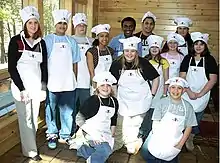
YMCA camping began in 1885 when Camp Baldhead (later known as Camp Dudley) was established by G.A. Sanford and Sumner F. Dudley on Orange Lake in New Jersey as the first residential camp in North America in operation today.[45] The camp later moved to Lake Champlain near Westport, New York.[13]
Camping also had early origins in YMCA movement in Canada with the establishment in 1889 of Big Cove YMCA Camp in Merigomish, Nova Scotia.[54] The Montreal YMCA organization also opened a summer camp named Kamp Kanawana nearby in 1894. In 1919 YMCAs began their Storer Camps chain around the country.[55]
Publishing
YMCA founded YMCA Press publishing house in Russia in 1900. It moved to Paris after World War I, where it focused on providing intellectual and educational works to Russian émigrés.
YMCA Press published some of Aleksandr Solzhenitsyn's books while he was imprisoned by the Russian government.[56]
Religion
The first YMCA included Bible studies, although the organization has generally moved on to a more secular approach to youth work. Around six years after its birth, an international YMCA conference in Paris decided that the objective of the organization should become "Christian discipleship developed through a program of religious, educational, social and physical activities" (Binfield 1973:265).
Europe

United Kingdom and Ireland
YMCA in the United Kingdom and Ireland consists of three separate National Councils: England & Wales, Ireland, and Scotland. YMCAs in Wales joined YMCA England in 2017, leading to England’s National Council being renamed to YMCA England & Wales.
YMCAs in England and Wales offer supported accommodation for vulnerable and homeless young people, mental health services, youth clubs, sports centres, nursery schools and family support and after school clubs. Across England and Wales, YMCA supports more than 18,000 young people with homes each year,[40] and is thus one of the largest providers of safe supported accommodation for young people. The vast majority of this accommodation is supported by a range of personal, social and educational services.
The archive of YMCA England & Wales is housed at the University of Birmingham Special Collections. The archive of YMCA Scotland is available at the National Archives of Scotland.
Germany
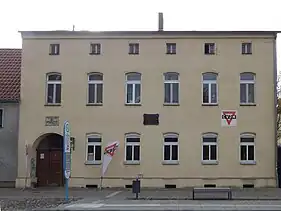
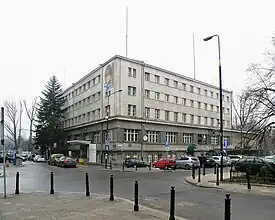
In Germany (as well as Austria and Switzerland) YMCA is called CVJM, which stands for Christlicher Verein junger Menschen (Christian Association of Young People). Up until 1985 the organisation was called 'Christlicher Verein Junger Männer' (Christian Association of Young Men), the name change reflected its activities being accessible to men and women.
Sweden
YWCA-YMCA of Sweden (Swedish: KFUK-KFUM Sverige) was established in 1966 following a merger of YMCA of Sweden and the YWCA of Sweden. In 2011, the organization decided to use the term KFUM Sverige during promotion where M now stands for människor ("people") instead of män (men) as before. YWCA-YMCA of Sweden has 40,000 members in 140 local associations. Several Swedish YWCA-YMCA associations have been successful in sport.
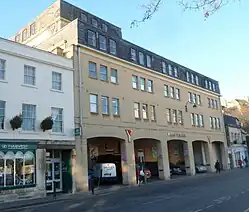
North America
The first YMCA in North America opened in Montreal, Quebec, Canada, on 25 November 1851.[57]
United States
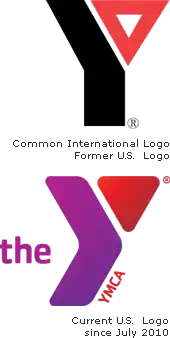
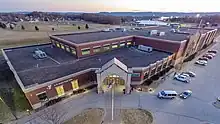
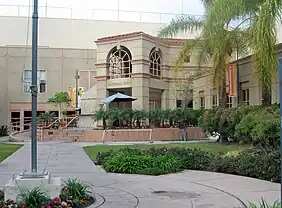
In the United States, YMCA is more commonly known as 'The Y' with its national office headquartered in Chicago. It has 800 separate organisational entities affiliated to its national office, based in 2,700 branch locations,[58] working with 21 million people, to "strengthen communities through youth development, healthy living and social responsibility."[59] It has about 19,000 staff and 600,000 volunteers.
Its major programs include after-school activities, day care, youth work and physical fitness. A large number of its service locations have gyms, weight rooms, swimming pools, and sports courts where basketball and other sports are played.
The first YMCA in the United States opened on 29 December 1851, in Boston, Massachusetts. It was founded in 1851 by Captain Thomas Valentine Sullivan (1800–59), an American seaman and missionary. In 1853 the Reverend Anthony Bowen founded the first YMCA for Colored Men in Washington, D.C. The renamed Anthony Bowen YMCA is still serving the U Street area of Washington. It became a part of YMCA of the city of Washington in 1947. Through the middle part of the 20th century it was associated with homosexual subculture, with the athletic facilities providing cover for closeted individuals.[60][61]
.jpg.webp)
YMCAs in the USA have been one of the largest charitable nonprofits in the United States, in terms of donations received from the general public, as listed by Forbes magazine.[62] YMCA in the USA is one of the many organizations that espouses muscular Christianity.[63][64][65][66][67]


Its national archives are located at the Kautz Family YMCA, a unit of the University of Minnesota Libraries Department of Archives and Special Collections.
Activities
.jpg.webp)
Activities at the YMCA in the United States include aquatics, arts and humanities, camps, child care, family activities, health and fitness, and various sports.[68]
Aquatics ranges from recreational classes to competitive swimming. Classes are offered for parent-child, preschool, youth, family, teen and adult. As well as there are arthritics classes and other water therapies. Certain YMCA's also offer a special Olympic swim class or swim team. CPR and first aid classes are offered to not only their employees but to the public to take as well. Away from swim classes, individuals can also take water polo lessons, water fitness lessons, or take part in the open swim times where families can swim in a lane to themselves.[68]
Arts and humanities at the YMCA are lessons for the members or non-members of the Y to take. These lessons range from visual arts (ceramics, drawing, painting, photography), performing arts (music, dance, poetry), and literature (reading, storytelling, public readings). These programs are not offered at each YMCA but the ones who have same to offer these programs give a benefit to their communities to give children a safe place to go to enjoy such activities.[68]
Camping at the YMCA is various day camps offered throughout the summer and winter breaks. These day camps are for youth and teens for them to spend a summer/winter in a safe environment staying active. There are outdoor camps where they do outdoor activities such as swimming, walking trails, etc., indoor camps that range from cooking to different sports (basketball, gymnastics, volleyball). There are also camps offered for special needs individuals, sailing camps, and family camps. Teens can also take part in the camp counselor program where they learn about being a part of a program during one part of their day and then they are a junior camp counselor in one of the various camps the remainder of the day.[68]
Child Watch or Child Care at the YMCA offers a supervised space for infants, toddlers, preschoolers, and school-age children to stay and play while parents enjoy a workout. Children at Child Watch will engage in playtime activities that foster learning and social interaction. YMCA staff members are trained to ensure the safety and well-being of the children in their care so that parents can confidently pursue their fitness goals or take part in the various YMCA programs. Child Watch at the YMCA is not only a reliable resource for parents but also a place where children can make friends, learn, and have fun in a supportive and inclusive environment.[68]
Family programs available are family nights, parent-child classes, and different events put on by the YMCA. These events could range from a trick or treating event, where parents can bring their child to trick or treat at the YMCA or a parent-child gymnastics class.[68]
Health and Fitness at the YMCA includes group exercise, lifestyle classes, personal training, strength training, weight management, and youth fitness. Group classes offered are cycling classes, aerobics, and kickboxing. Members can take part in programs such as the Loose Big which is a program where individuals can work out with a group and a trainer to improve their lifestyle and lose weight. Youth fitness classes include swim, gymnastics, basketball, etc.[68]

_Building_Allentown_PA.jpg.webp)
Sports at the YMCA that are offered range from baseball, basketball, gymnastics, football, wrestling, karate, volleyball, soccer, and racquetball. The programs offered depend on the location of the YMCA and the amount of space they have for the various programs. These programs are also offered to different age groups such as preschool, youth, teen, and special needs. The goal of the YMCA is to offer these activities to all populations.[68]

Parent/child programs
YMCA's parent/child programs, under the umbrella program called Y-Guides, (originally called YMCA Indian Guides, Princesses, Braves, and Maidens) have provided structured opportunities for fellowship, camping, and community-building activities (including craft-making and community service) for several generations of parents and kids in kindergarten through eighth grade.[69]
After-school programming
YMCA after-school programs are geared towards providing students with a variety of recreational, cultural, leadership, academic, and social skills for development.
Residences
Until the late 1950s,[11] YMCAs in the United States were built with hotel-like rooms called residences or dormitories. These rooms were built with the young men in mind coming from rural America and many foreign-born young men arriving to the new cities. The rooms became a significant part of American culture, known as an inexpensive and safe place for a visitor to stay in an unfamiliar city (as, for example, in the 1978 Village People song "Y.M.C.A."). In 1940, there were about 100,000 rooms at YMCAs, more than any hotel chain. By 2006, YMCAs with residences had become relatively rare in the US, but many still remain.[70] YMCA of Greater Seattle turned its former residence into transitional housing for former foster care and currently homeless youth, aged 18 to 25. This YMCA operates six transitional housing programs and 20 studio apartments. These services are offered at their Young Adult drop-in center in Seattle, Washington.[71]
Canada
YMCA Canada was established over 160 years ago as a charity.[72] Today, there are 44 YMCAs and 5 YMCA-YWCAs in Canada that offer programmes and services tailored to each community's needs. Together they serve 2 million people in more than 1,000 communities across Canada.[72] Available programs include
- Children and Youth
- Health, Fitness and Recreation
- Childcare
- Day and Resident Camping
- Employment Training
- Community Outreach and Newcomer Services
- International Development and Education
- Leadership Development and Recognition
YMCA financial assistance programs help to make YMCA accessible to everyone.[73]
Its archives are held by Library and Archives Canada. Until 1912, when Canadian YMCAs formed their own national council, YMCAs were jointly administered by the International Committee of the Young Men's Christian Associations of North America.
Mexico
Mexico's first YMCA branch opened in Mexico City in 1902 for the American community. By 1904, there were two more branches in Mexico City and one branch established in Monterrey. In 1907, another branch in Chihuahua was set up and then one YMCA in Tampico. In Mexico, YMCA organized physical activity, individual development, and national progress. There was advertising for YMCA programs that would help young men gain life skills and YMCA also had some activities for women. For example, an excursion to Xochimilco in 1910 featured races for boys and girls and indoor baseball for everyone. YMCA had very little influence on rural Mexico until after the Mexican Revolution.[74]
Panama
In 1904, a letter was written by the chief engineer of the Panama Canal Zone, John Findley Wallace, to Admiral J.G. Walker, chairman of the Isthmian Canal Commission, recommending that YMCA be brought to the Canal Zone. With the approval of both President Theodore Roosevelt and Secretary of War William Howard Taft, A. Bruce Minear, an experienced secretary, was sent to organize the association work in the Canal Zone.[75] Construction was started on YMCA clubhouses in Culebra, Empire, Gorgona, and Cristobal, Panama, as well as in Panama City. These clubhouses were operated by YMCA for several years and were financed by the Canal Zone, they contained billiard rooms, an assembly room, a reading room, bowling alleys, dark rooms for the camera clubs, gymnastic equipment, an ice cream parlor and soda fountain, and a circulating library. By 1920, there were nine buildings in operation in the Canal Zone.

Panama YMCA was founded on 24 May 1966.[75] The 1968 impeachment of President Marco Aurelio Robles and the ensuing riots and political unrest impacted YMCA's work and the after-school programs at Panama YMCA were cancelled. Use of the school equipment, such as the pool and gym, greatly helped YMCA's ability to continue on with the swimming classes and summer programs. These programs remained popular throughout this time.
In 1983, planning was started for the integration of Panama YMCA and the American Services YMCA (ASYMCA). The integration of the remaining two ASYMCAs, the Balboa Branch and the Cristobal Branch, with the Panama Branch, a merger that was completed in 1990.
YMCA Panama continues its work for the betterment of today's society. In 2005, YMCA Panama inaugurated the new YMCA Panama School located on Colinas del Sol, in the Nuevo Chorrillo District of Arraijan.
South America
Argentina
YMCA developed in 1902 in Argentina, where it provided support for physical education teachers. YMCA was most notable in encouraging women's sports in South America, and during the early 1900s, YMCA in Argentina highly promoted basketball, swimming, and track and field. There were many victories for the development of sports in Argentina due to YMCA, such as Frederick Dickens, who served as the director of physical education at the Buenos Aires YMCA. Dickens eventually led the Argentine Olympic delegation to Paris in 1924 and Amsterdam in 1928.[74]
Brazil
YMCA developed in 1893 in Brazil and volleyball was deemed appropriate for women from the beginning. Through the encouragement of YMCA, physical educators promoted women's volleyball in schools like Escola Wenceslau Braz and Colégio Sylvio Leite in Rio. Sports clubs even began to organize events for women because of YMCA's influence.[74]
Peru
YMCA Peru has a team of 200 employees and a voluntary body of more than 700 people.[76] The organization describes its mission as "Having a positive impact on the young people so they have the will to transform the Peruvian society".[77] YMCA Peru was created on 17 May 1920. It has presence in the departments of Lima, Arequipa, and Trujillo.[77]
Africa

YMCAs in Africa are united under the Africa Alliance of YMCAs (AAYMCA).[78] The core focus of the organizational work done by the AAYMCA is youth empowerment. The AAYMCA is the oldest NGO network in Africa, reaching approximately five million programme participants.[79] The first YMCA in Africa was established in Liberia in 1881,[80] and the AAYMCA was founded in 1977 as the umbrella body for all national movements on the continent.[80] The AAYMCA collaborates with national movements to conduct research, develop localized as well as continental programming, monitor and evaluate progress, and communicate impact of youth development work undertaken on the continent.[80][81][82] From 2015, the Africa Alliance of YMCAs has aligned much of its programmatic work to some of the goals set out by the African Union's Agenda 2063 Development Plan in order to contribute towards the achievement of the ideals envisioned by the African Renaissance.[83]

In 1975, Africa's YMCAs (or at least half of the continent's countries) tried to revive the ones in Cote d'Ivoire and Kenya, followed by Madagascar, Jordon, Surime and Angola. Curreltly, Africa holds the World YMCA locations by buliding models.
Subject to Citizen Change Model
Many of the Africa YMCA projects and programmes are influenced by the Subject to Citizen (S2C) Change Model. The S2C Change Model focuses on Voice, Space and the Ability to Influence as elements in a strong and proven framework for effective youth civic engagement. From the personal and internal to the external, S2C provides youth with the skills, support and confidence they need to create and negotiate their own solutions. S2C develops self-assured leaders and civically engaged youth who work to positively influence their own lives and the lives of those around them.[84][85]
African YMCA movements
Active movements: Angola, Côte d'Ivoire, Cameroon, Egypt, Ethiopia, Ghana, Kenya, Uganda, Liberia, Madagascar, Nigeria, Senegal, Sierra Leone, South Africa, Tanzania, The Gambia, Togo, Zambia, Zimbabwe[80][86]
Associate movements: Niger, Rwanda, South Sudan[86]
Movements in formation: Malawi, Namibia[87]
India Pacific
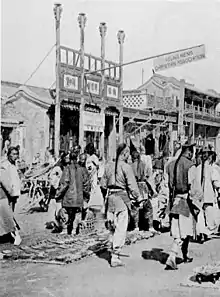
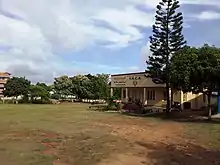

China
In 1911, the YMCA appointed J. Howard Crocker to serve as the foreign work secretary to promote physical education based in Shanghai, the headquarters of all YMCA work in China.[88][89] When he first arrived in China, the YMCA had facilities in large cities, but lacked a nationally co-ordinated effort.[90] In 1911, he arranged the first school for physical education directors in China.[91] With the support of president Yuan Shikai, Crocker toured China to conduct training courses and establish a school for physical education instructors.[90] Shanghai subsequently became the first training centre for physical education directors in China.[91]
Hong Kong
YMCA Hong Kong was established in 1901, being separated into two separate organizations in 1908, split across linguistic lines: "YMCA of Hong Kong" and "Chinese YMCA of Hong Kong". YMCA Hong Kong headquarters has occupied its current location at 22 Salisbury Road, Tsim Sha Tsui since 1922. YMCA Hong Kong established the College of Continuing Education in 1996[92] and YMCA of Hong Kong Christian College in 2003.[93]
Middle East
Jerusalem

In 1924, Archibald Clinton Harte, General Secretary of the International YMCA, raised the sum of one million dollars towards the construction of the building.[94] The Jerusalem YMCA was dedicated in 1933 with the words “Here is a place whose atmosphere is peace, where political and religious jealousies can be forgotten and international unity be fostered and developed.” Harte's home on the shores of Galilee was bequeathed to the Jerusalem International YMCA as an international conference facility.[95] The cornerstone was laid in 1928 by Lord Plumer, the British High Commissioner for Palestine, on a plot of land in the West Nikephoria section of Jerusalem, purchased from the Greek Orthodox Patriarchate of Jerusalem.[96] The building was designed by the American architect Arthur Loomis Harmon of Shreve, Lamb and Harmon, who designed the Empire State Building. The Jerusalem YMCA housed the city's first heated swimming pool and first gymnasium with a wooden floor. The first concert broadcasts of the Voice of Israel radio station were transmitted from the YMCA auditorium.
In 1947, the YMCA was the venue of the UNSCOP talks leading up to the UN Partition Plan.[97] At the end of April 1948 the building was taken over by the International Red Cross, sheltering around 80 refugees. Two months later it was used by the UN Mediation Committee headed by Count Bernadotte and in September it was taken over by the US Consulate with US guards and naval telecommunications equipment. The building was restored to the YMCA in April 1949.[96]
Gaza
In 1952, the YMCA in Gaza city was started with the support of Egypt YMCA. Gaza YMCA was an Egyptian branch until Israel’s occupation in 1967. Since 1967, it has not belonged to any State for international political reasons and consequently has not been a part of any national movement. The YMCA has five major departments: sports, arts, welfare, preschool, and youth. The youth department consists of approximately 80 youth leaders between the ages of 15 and 25 years old.
Despite having a strong Christian identity, the YMCA in Gaza is well respected in the Muslim community. Approximately 750 youth go to the YMCA per week, and the majority of YMCA attendees are Muslim. The staff are both Muslim and Christian, and the elected board is 100% Christian to balance inclusivity without losing the YMCA’s Christian identity. The YMCA teaches youth about religious tolerance.[98]
Nobel Peace Prize laureates
- 1901: Henry Dunant, who co-founded the Geneva YMCA in 1852 and was one of the founders of the World YMCA, was awarded the first-ever Nobel Peace Prize for founding the International Committee of the Red Cross in 1863, and inspiring the Geneva Conventions (Conventions de Genève). He shared the prize with Frédéric Passy, founder and president of the first French peace society.
- 1946: John R. Mott, US, president of the World YMCA, was awarded the Nobel Peace Prize for his "long and fruitful labors in drawing together the peoples of many nations, many races and many communions in a common bond of spirituality." John R. Mott also played an important role in the founding of the World Student Christian Federation in 1895, the 1910 World Missionary Conference and the World Council of Churches in 1948.
See also
Notes
- ↑ The Fédération Internationale de Volleyball credits Crocker for introducing volleyball to China via the YMCA.[48] Crocker wrote in a letter than the introduction of volleyball to China occurred in 1912.[49]
References
Citations
- ↑ "Blue Book". World Alliance of YMCAs. 10 July 2018. Retrieved 10 November 2018.
- ↑ Heath, Gordon L. (31 October 2016). American Churches and the First World War. Wipf and Stock Publishers. ISBN 9781532601149.
- ↑ Ferentinos, Susan (16 December 2014). Interpreting LGBT History at Museums and Historic Sites. Rowman & Littlefield. ISBN 9780759123748.
- ↑ "YMCA Founder's Day: Celebrating 170 Years — Greater Joliet Area YMCA". www.jolietymca.org. Retrieved 6 June 2019.
- ↑ One or more of the preceding sentences incorporates text from a publication now in the public domain: Chisholm, Hugh, ed. (1911). "Young Men's Christian Association". Encyclopædia Britannica. Vol. 28 (11th ed.). Cambridge University Press. pp. 940–941.
- ↑ Report of the Thirteenth International Conference: xix
- 1 2 Cannon, John (2015). A Dictionary of British History. Oxford University Press. ISBN 9780191044809.
- ↑ Finnegan, Diarmid A. (2011). Journal of Victorian Culture. pp. 46–64.
- 1 2 3 J. William Frost, "Part V: Christianity and Culture in America", Christianity: A Social and Cultural History, 2nd Edition, (Upper Saddle River: Prentice Hall, 1998), 476.
- ↑ "Paris Basis". Ymca.int. Retrieved 1 July 2012.
- 1 2 "US YMCA's history page". Ymca.net. Archived from the original on 10 March 2010. Retrieved 1 July 2012.
- ↑ "History". Hotel Arthur.
- 1 2 Turner, Eugene A. Jr. (1985). "100 Years of YMCA Camping". YMCA of the USA. Retrieved 4 August 2020 – via umn.edu.
- ↑ "YMCA Building Photo". Vintpix.com. 4 July 2009. Retrieved 1 July 2012.
- ↑ "YMCA Through the Years". YMCA.org.uk. Retrieved 15 November 2021.
- ↑ "No. 30460". The London Gazette (Supplement). 7 January 1918. p. 368.
- ↑ "Window on My Heart. Chapter X. The War Years". 18 April 2007. Archived from the original on 18 April 2007. Retrieved 22 December 2019.
- ↑ "Christmas Day in the London Bridge YMCA Canteen: HRH Princess Helena Victoria, Chairman of the Ladies' Auxiliary Committee of the YMCA is standing by Mrs Norrie, CBE, Superintendent of the canteen. Miss Ellen Terry is sitting by the table". Imperial War Museums. Retrieved 22 December 2019.
- ↑ Mayo, Katherine (May 2009). 'That Damn Y' a Record of Overseas Service. Bibliographical Center for Research. ISBN 9781110810208. Retrieved 9 October 2009.
- ↑ Zeitoun, Sabine (1 January 2011). "Accueil des enfants juifs étrangers en France et leur sort sous l'Occupation". Documents pour l'histoire du français langue étrangère ou seconde (46): 123–144. doi:10.4000/dhfles.2108 – via journals.openedition.org.
- ↑ Ryan, Donna F. (11 June 1996). The Holocaust & the Jews of Marseille: The Enforcement of Anti-Semitic Policies in Vichy France. University of Illinois Press. ISBN 9780252065309 – via Google Books.
- ↑ Donald Lowrie, The Hunted Children, 1963.
- ↑ "Collection: YMCA film bureau records | University of Minnesota Archival Collections Guides". Retrieved 25 January 2020.
- ↑ Staff. "History of YMCA Underwater Program". Diving History.com. Archived from the original on 15 December 2010. Retrieved 13 January 2011.
- ↑ Richardson, Drew (1999). "A brief history of recreational diving in the United States". South Pacific Underwater Medicine Society Journal. 29 (#3). Archived from the original on 15 May 2009. Retrieved 13 January 2011.
{{cite journal}}: CS1 maint: unfit URL (link) - ↑ Kendrick, DF (2009). "Science of the National Association for Cave Diving (NACD): Water Quality, Hydrogeology, Biology and Psychology". In: Pollock NW, ed. Diving for Science 2009. Proceedings of the American Academy of Underwater Sciences 28th Symposium. Dauphin Island, AL: AAUS; 2009. Archived from the original on 5 July 2013. Retrieved 20 April 2013.
{{cite journal}}: CS1 maint: unfit URL (link) - ↑ "Kampala Principles". Ymca.int. Retrieved 1 July 2012.
- ↑ "Challenge 21 - 1998". YMCA International - World Alliance of YMCAs. Archived from the original on 21 December 2019. Retrieved 21 December 2019.
- ↑ "World Alliance of YMCAs Issues Statement on YMCA USA Rebrand". 14 July 2010. Archived from the original on 9 June 2011. Retrieved 4 April 2011.
- ↑ "History of YMCA logo". Green Bay YMCA. Archived from the original on 6 January 2019. Retrieved 6 January 2019.
- ↑ "World YMCA celebrates International Youth Day 2018". YMCA International - World Alliance of YMCAs. 8 August 2018. Retrieved 21 December 2019.
- ↑ BST, Rob James Wed 7 August 2019 10:24 (7 August 2019). "The YMCA at 175: from a small drapery store to a global Christian youth movement". www.christiantoday.com. Retrieved 21 December 2019.
{{cite web}}: CS1 maint: numeric names: authors list (link) - ↑ Strub, Chris. "YMCA Ambassadors From 100+ Nations Join in London To Commemorate 175 Years At #Y175". Forbes. Retrieved 21 December 2019.
- ↑ Zald, Mayer N.; Denton, Patricia (September 1963). "From Evangelism to General Service: The Transformation of the YMCA". Administrative Science Quarterly. 8 (#2): 214–234. doi:10.2307/2390900. JSTOR 2390900.
- ↑ "20th YMCA World Council to be hosted in Aarhus, Denmark". YMCA International - World Alliance of YMCAs. 1 November 2019. Retrieved 21 December 2019.
- ↑ Shedd, Clarence Prouty (1955). History of the World's Alliance of YMCA. London. pp. Appendix 1.
{{cite book}}: CS1 maint: location missing publisher (link) - ↑ "YMCA Logo - History". World YMCA.
- ↑ "Luther Halsey Gulick: recreation, physical education and the YMCA – infed.org".
- ↑ "YMCA changes its logo to just 'The Y'". The Washington Times. Retrieved 28 December 2021.
- 1 2 "Accommodation". YMCA England & Wales. Retrieved 21 December 2019.
- ↑ "Y Learning, standardized tutorial program | YMCA of the Triangle". www.ymcatriangle.org. Retrieved 6 February 2018.
- ↑ "Coalition YMCA Universities". Retrieved 21 December 2019.
- ↑ Rosenberg, Tina (3 July 2014). "At a YMCA Near You, a Course for a Diabetic Nation". Opinionator. Retrieved 6 June 2019.
- ↑ Smith, Daniel (30 January 2018). "History Lesson: Early basketball at YMCA". Courier & Press. Retrieved 2 January 2018.
- 1 2 Weeks, Linton (2 June 2015). "How The YMCA Helped Shape America". NPR. Retrieved 16 April 2020.
- ↑ "Article". The Statesman of Salem, Oregon. 7 February 1931.
- ↑ Loucky, Wallechinsky, David and Jamie (2008). The Complete Book of the Olympics. London: Aurum Press Limited. pp. 399–400.
- ↑ "History – Volleyball". Fédération Internationale de Volleyball. 2022. Archived from the original on 4 December 2022. Retrieved 28 January 2023.
- ↑ "Another Letter From J. H. Crocker". Brantford Expositor. Brantford, Ontario. 25 June 1912. p. 10. Archived from the original on 28 April 2023. Retrieved 28 May 2023.
- ↑ "Popular sports invented at YMCA" by Jill Fandrich, 25 May 2009
- ↑ "YMCA and Early Gymnastics". History of YMCA National Gymnastics Championships. Retrieved 15 November 2021.
- 1 2 Lyons, Stephanie (18 July 2008). "Gymnastics, an Olympic favorite, evolves with YMCA". Salem News. Retrieved 15 November 2021.
- ↑ "Futsal History". www.usyouthfutsal.com. Retrieved 29 December 2020.
- ↑ "YMCA Timeline : 1880–1899". Ymca.ca. Archived from the original on 3 April 2007. Retrieved 1 July 2012.
- ↑ "Our History". Retrieved 19 April 2015.
- ↑ Marc Raeff (1990). Russia Abroad: A Cultural History of the Russian Emigration, 1919-1939. Oxford University Press. pp. 78. ISBN 978-0-19-505683-9.
- ↑ "The YMCAs of Quebec - Our History".
- ↑ "Who We Are". YMCA.net. 11 April 2017.
- ↑ "Welcome to the Y". YMCA.org. Retrieved 19 April 2015.
- ↑ Neumann, Caryn E. glbtq: An Encyclopedia of Gay, Lesbian, Bisexual, Transgender, and Queer Culture. YMCA. Archived 4 March 2013 at the Wayback Machine
- ↑ Johnson, David K. "Take the Stranger by the Hand: Same-Sex Relations and the YMCA". gaybookreviews.info. Archived from the original on 16 March 2012. Retrieved 16 March 2012.
- ↑ "YMCA of the USA". Forbes. Retrieved 21 December 2019.
- ↑ Yamane, David; Roberts, Keith A. (2012). Religion in Sociological Perspective. Pine Forge Press. ISBN 9781412982986. Retrieved 1 August 2011.
Through use of these facilities, as well as camping trips and baseball leagues, YMCA used sport and teamwork to expose young men to Muscular Christianity and "lead men to Christ."
- ↑ Earl Smith (2010). Sociology of Sport and Social theory. Human Kinetics. ISBN 9780736075725. Retrieved 1 August 2011.
Through use of these facilities, as well as camping trips and baseball leagues, YMCA used sport and teamwork to expose young men to Muscular Christianity and lead men to Christ.
- ↑ Stacy C. Boyd (2007). Black Men Worshiping: Intersecting Anxieties of Race, Gender and Christian Embodiment. Emory University. ISBN 9780549215912. Retrieved 1 August 2011.
Clifford Putney pays special attention to YMCA and the way its underlying philosophy changed to embrace the bodily emphasis of muscular Christianity.
- ↑ Ruth Clifford Engs (2001). Clean Living Movements: American Cycles of Health Reform. Greenwood Publishing Group. ISBN 9780275975418. Retrieved 1 August 2011.
Out of this concern came church-related brotherhoods and character-building programs within YMCA, which personified the ideals of Muscular Christianity and manliness.
- ↑ Arieh Sclar (2008). "A Sport at which Jews excel": Jewish basketball in American society, 1900–1951. State University of New York at Stony Brook. ISBN 9780549922049. Retrieved 1 August 2011.
YMCA helped legitimate sport among the Christian public by serving as the symbolic and material site of 'muscular Christianity.'
- 1 2 3 4 5 6 7 8 "YMCA USA". YMCA International - World Alliance of YMCAs. Retrieved 23 November 2021.
- ↑ Michelle Malkin (12 September 2003). "P.C. vs. the Indian Princesses". Townhall.com. Retrieved 1 July 2012.
- ↑ "Glendale, California YMCA". Archived from the original on 27 September 2007. Retrieved 4 April 2011., "McGaw YMCA – Evanston, Illinois". Retrieved 4 April 2011., "Berkeley, California YMCA". Retrieved 4 April 2011.
- ↑ "YMCA Young Adult Services, Seattle, WA". Retrieved 17 January 2012.
- 1 2 "YMCA Canada - Who We Are". www.ymca.ca. Archived from the original on 24 November 2015. Retrieved 23 November 2015.
- ↑ "YMCA Canada - Who We Are". www.ymca.ca. Archived from the original on 24 November 2015. Retrieved 23 November 2015.
- 1 2 3 Elsey, Brenda; Nadel, Joshua (21 May 2019). Futbolera. University of Texas Press. ISBN 978-1477310427.
- 1 2 "Collection: Records of YMCA international work in Panama | University of Minnesota Archival Collections Guides". archives.lib.umn.edu. Retrieved 13 March 2020.
- ↑ "Nosotros – YMCA Peru". ymcaperu.org.
- 1 2 "YMCA Peru – Asociación Cristiana de Jóvenes del Perú". ymcaperu.org.
- ↑ "Africa Alliance of YMCAs website".
- ↑ "AAYMCA Annual Report" (PDF). Archived (PDF) from the original on 9 October 2022.
- 1 2 3 4 "Archives & Special Collections · University of Minnesota Libraries". www.lib.umn.edu. 8 September 2023.
- ↑ volunteer, Christine Davis, Africa Alliance of YMCAs (1 April 2010). "Transactional sex, HIV and livelihoods". Modern Ghana. Retrieved 17 May 2016.
{{cite web}}: CS1 maint: multiple names: authors list (link) - ↑ "Ghana YMCA technical training addresses critical educational gaps". Modern Ghana. 14 September 2009. Retrieved 17 May 2016.
- ↑ "Agenda2063". ymca2063.org. Archived from the original on 10 August 2016. Retrieved 17 May 2016.
- ↑ "Africa YMCA | Subject 2 Citizen". www.africaymca.org. Archived from the original on 2 May 2016. Retrieved 17 May 2016.
- ↑ "YMCA World Magazine - From Subject to Citizen". Issuu. 21 July 2011. Retrieved 17 May 2016.
- 1 2 "Africa YMCA | Vision and Mission". www.africaymca.org. Archived from the original on 11 June 2016. Retrieved 17 May 2016.
- ↑ "YMCA Namibia". www.facebook.com. Retrieved 13 October 2022.
- ↑ "Mr. Crocker Will Be Sent To China". Brantford Expositor. Brantford, Ontario. 18 May 1911. p. 1. Archived from the original on 28 April 2023. Retrieved 28 May 2023.
- ↑ National Council of Young Men's Christian Associations of Canada (November 1930). "Howard Crocker's Resignation". The News Bulletin. Toronto, Ontario. pp. 1–2.
- 1 2 Henderson, Jim (22 September 1956). "Retire at 60? No, Sir! Dr. J. Howard Crocker Carved a Second Career". Brantford Expositor. Brantford, Ontario. p. 18. Archived from the original on 18 April 2023. Retrieved 28 May 2023.
- 1 2 "Y.M.C.A. Supremacy in Physical Education". Brantford Expositor. Brantford, Ontario. 19 January 1918. p. 18. Archived from the original on 29 April 2023. Retrieved 28 May 2023.
- ↑ YMCA Hong Kong About Us. History at a Glance, 2015
- ↑ YMCA of Hong Kong Christian College The first secondary school sponsored by YMCA Hong Kong.
- ↑ "YMCA INTERNATIONAL WORK IN PALESTINE AND ISRAEL: An Inventory of Its Records". Kautz Family YMCA Archives. University of Minnesota. Retrieved 10 February 2016.
- ↑ "Archibald Harte". Archived from the original on 17 January 2017. Retrieved 16 September 2022.
- 1 2 YMCA history
- ↑ The Consul General at Jerusalem (Macatee) to the Secretary of State
- ↑ "Occupied Palestinian territory: Report from the International YMCA-YWCA Observer: No. 17 - Gaza - why do you want to go there? - occupied Palestinian territory | ReliefWeb". reliefweb.int. 16 November 2001. Retrieved 2 January 2024.
Sources and further reading
- Alleman, Nathan F., and Dorothy E. Finnegan. "'Believe you have a mission in life and steadily pursue it': Campus YMCAs presage student development theory, 1894–1930." Higher Education in Review 6.1 (2009): 33+ online.
- Baker, William J. "To Play or to Pray? The YMCA Question in the United Kingdom and the United States, 1850-1900". International Journal of the History of Sport 1994 11#1: 42-62
- Fischer-Tiné, Harald, Stefan Huebner and Ian Tyrrell, eds. Spreading Protestant Modernity: Global Perspectives on the Social Work of the YMCA and YWCA (c. 1889–1970) (University of Hawai’i Press, 2020) abstract.
- Garnham, Neal. "'Both praying and playing:' Muscular Christianity" and the YMCA in north-east county Durham." Journal of Social History 35.2 (2001): 397-407, in England. online
- Hopkins, Charles Howard. History of the YMCA in North America (Association Press, 1951), a standard scholarly history History of the Y.M.C.A. in North America.
- Hosgood, Christopher P. "Negotiating Lower-Middle-Class Masculinity in Britain: The Leicester Young Men's Christian Association, 1870-1914." Canadian Journal of History 37.2 (2002): 253–274.
- Lord, Alexandra M. "Models of masculinity: sex education, the United States Public Health Service, and the YMCA, 1919–1924." Journal of the history of medicine and allied sciences 58.2 (2003): 123–152. online
- Macleod, David I. Building character in the American boy: The Boy Scouts, YMCA, and their forerunners, 1870-1920 (Univ of Wisconsin Press, 2004), a standard scholarly history.
- Muukkonen, Martti (2002). Ecumenism of the Laity: Continuity and Change in the Mission View of the World's Alliance of YMCAs, 1855–1955 (PDF). University of Joensuu. Publications in Theology 7. Archived (PDF) from the original on 9 October 2022.
- Putney, Clifford W. "Going Upscale: The YMCA and Postwar America, 1950-1990". Journal of Sport History 20#2 1993, pp. 151–166. online
- Vertinsky, Patricia, and Aishwarya Ramachandran. "The 'Y' Goes to India: Springfield College, Muscular Missionaries, and the Transnational Circulation of Physical Culture Practices". Journal of Sport History 46#3 2019, pp. 363–379. online
- Watson, Nick J., Stuart Weir, and Stephen Friend. "The development of muscular Christianity in Victorian Britain and beyond." Journal of religion and society 7 (2005) pp 7–21.online.
- Winter, Thomas. "Personality, Character, and Self-Expression: The YMCA and the Construction of Manhood and Class, 1877-1920." Men and Masculinities 2.3 (2000): 272–285.
Primary sources
- The Report of the Thirteenth Triennial International Conference and Jubilee Celebration of Young Men's Christian Associations. London: Jubilee Council. 1895.
External links
- Official website

- Additional archives about the importance of YMCA to Chicago Archived 31 August 2013 at the Wayback Machine, IL and to the African American History.
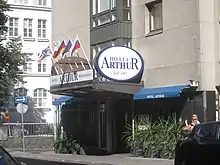
.jpg.webp)

